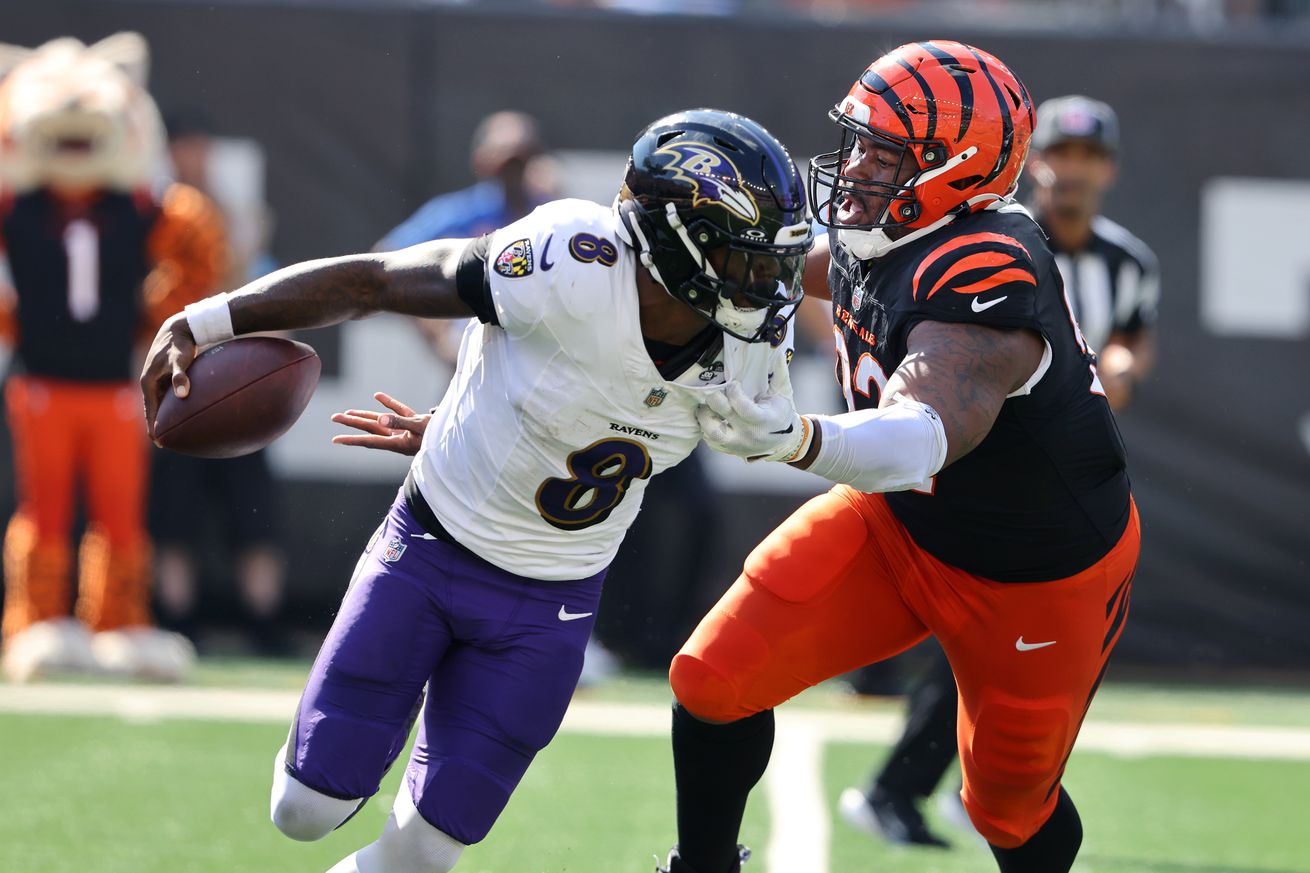
Welcome to Statistical Storylines, a new column on Baltimore Beatdown with a weekly statistical breakdown of the Ravens’ last matchup, using advanced metrics to tell the story of the game.
There’s only one number that truly matters at the end of a football game: the final score. But advancements in player tracking and the creative work of the NFL’s growing analytics wing has given fans a whole new way to understand how and why their team won (or lost).
Here are the key advanced metrics from the Baltimore Ravens’ 41-38 victory over the Cincinnati Bengals.
5.5% sack rate when pressured
Lamar Jackson was a miracle-worker on Sunday, taking just one sack despite 18 pressures and a 42.6% blitz rate by the Bengals defense, per NextGen Stats. Most teams would kill for a 5.5% sack rate across all dropbacks, but that was Jackson’s sack rate when pressured on Sunday. He’s a magician in the pocket and a ghost outside of it with an incredible ability to play through contact and break sacks while keeping his eyes downfield. His touchdown to Isaiah Likely was the game’s biggest highlight, but Jackson salvaged multiple drives with evasive maneuvers and timely throwaways behind the line of scrimmage to avoid negative plays.
7 (or 4) pressures allowed
Ronnie Stanley was charged with seven pressures allowed to Trey Hendrickson by NextGen Stats, but Pro Football Focus only counted three. The disparity in Stanley’s assessment by NGS and PFF highlights the importance of context and process when using advanced stats. NGS uses player GPS-tracking data to assign responsibility for pressures allowed, while PFF relies on film to determine culpability based on blocking assignments and defensive playcall as well as proximity. A film review of Stanley’s game shows that he held his own against Hendrickson in one-on-one matchups, but Cincinnati used simulated pressures and stunts to free Hendrickson up on other plays.
21.46 miles per hour
Remember how Derrick Henry’s 87-yard touchdown against Buffalo was just 0.17 mph slower than Xavier Worthy’s top speed this season? Henry caught up in Week 5, tying Worthy for the fourth-highest ballcarrier speed in 2024 on his 51-yard rush in overtime.
Henry is the only player above the age of 27 years old on NextGen Stats’ list of the 20 fastest ballcarrier speeds in the NFL this season. He’s also one of three players with two plays in the top 10 along with Ja’Marr Chase and Nico Collins.
5.1 average yards of separation per target
Rashod Bateman consistently got open on Sunday, averaging 5.1 yards of separation per target against the Bengals. He only caught four of his eight targets, but three of those incompletions were uncatchable passes by a scrambling Jackson.
.@R_bateman2 ❗#NextGenStats powered by @awscloud pic.twitter.com/MpmJi0iEJZ
— Baltimore Ravens (@Ravens) October 8, 2024
Bateman beat man and zone coverage alike to break free against the Bengals secondary, allowing Jackson to continue his trend of hitting wide-open receivers. Jackson leads the league with an average of 4.5 yards of separation per target and his 8.0% tight window rate is second-lowest behind Patrick Mahomes.
6 run stops, 5 pressures
The Ravens have invested in the spine of their defense in the last three years, most recently with Nnamdi Madubuike’s $98 million extension in March. After a somewhat quiet start to the season relative to his 2023 breakout, Madubuike returned to his game-wrecking ways on Sunday, recording five pressures and a third-quarter sack that ended the Bengals’ drive before it could even begin. Madubuike’s run defense also cleared paths for Roquan Smith to rack up six run stops, per PFF, on his way to 11 tackles in his best performance of the season. Not to be outdone, Kyle Hamilton played all over the field with three run stops, two pressures, and a third-down sack in the second quarter.
16% win percentage difference
Lamar Jackson’s overtime fumble dropped the Ravens’ win percentage to just 22% with the Bengals on the edge of field goal range after the turnover. But some extremely conservative playcalling from Zac Taylor gave Baltimore’s defense a chance to stuff three straight inside runs for a total of 3 yards. That brought the Ravens’ win percentage to 38% pending a 53-yard attempt from Evan McPherson, who entered Week 5 three-of-three from more than 50 yards. McPherson pulled it wide left, taking the game back to a near coin-flip before Henry’s 51-yard run sealed the win for Baltimore. Taylor will be regretting his decision-making in overtime, especially after Joe Burrow tore up a league-worst Ravens passing defense for much of the game.